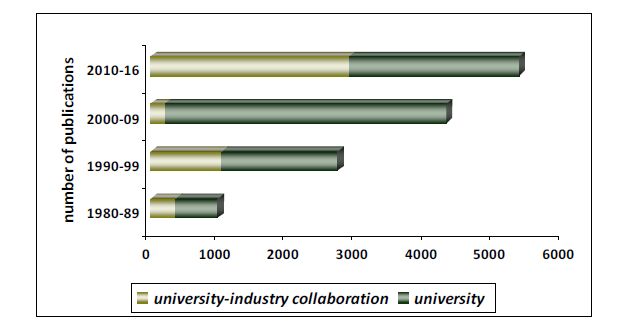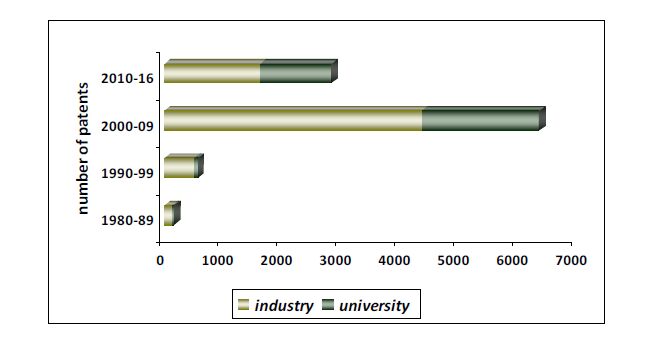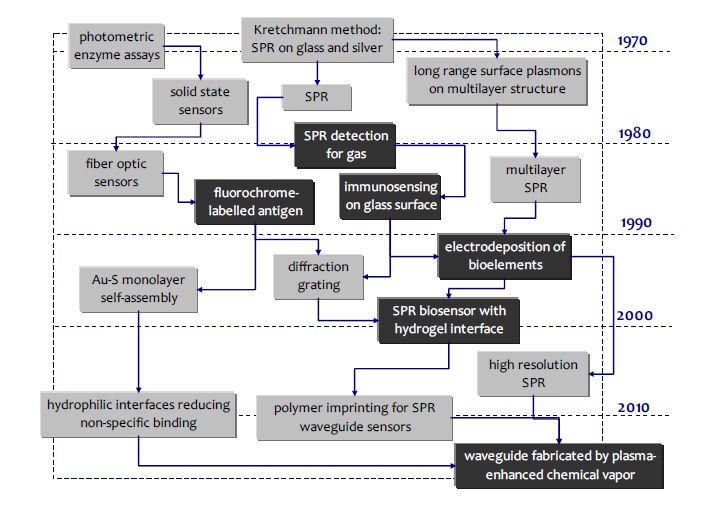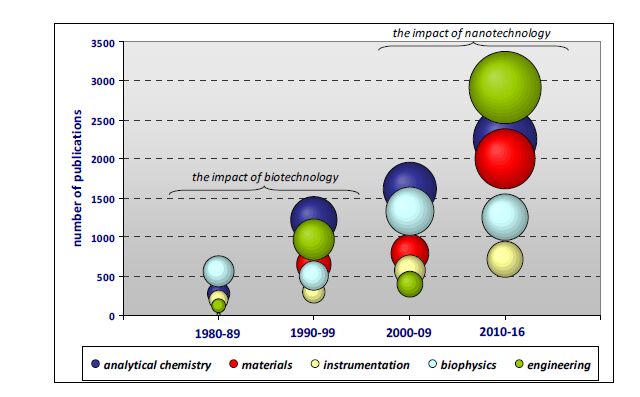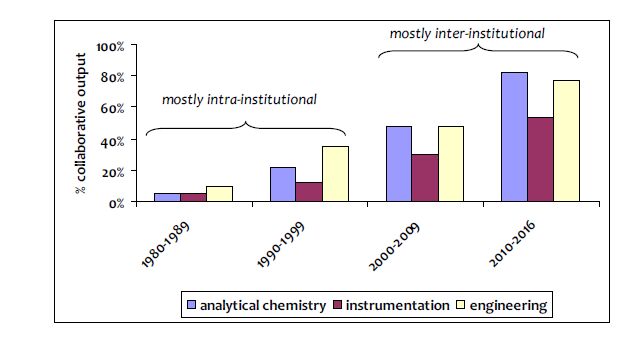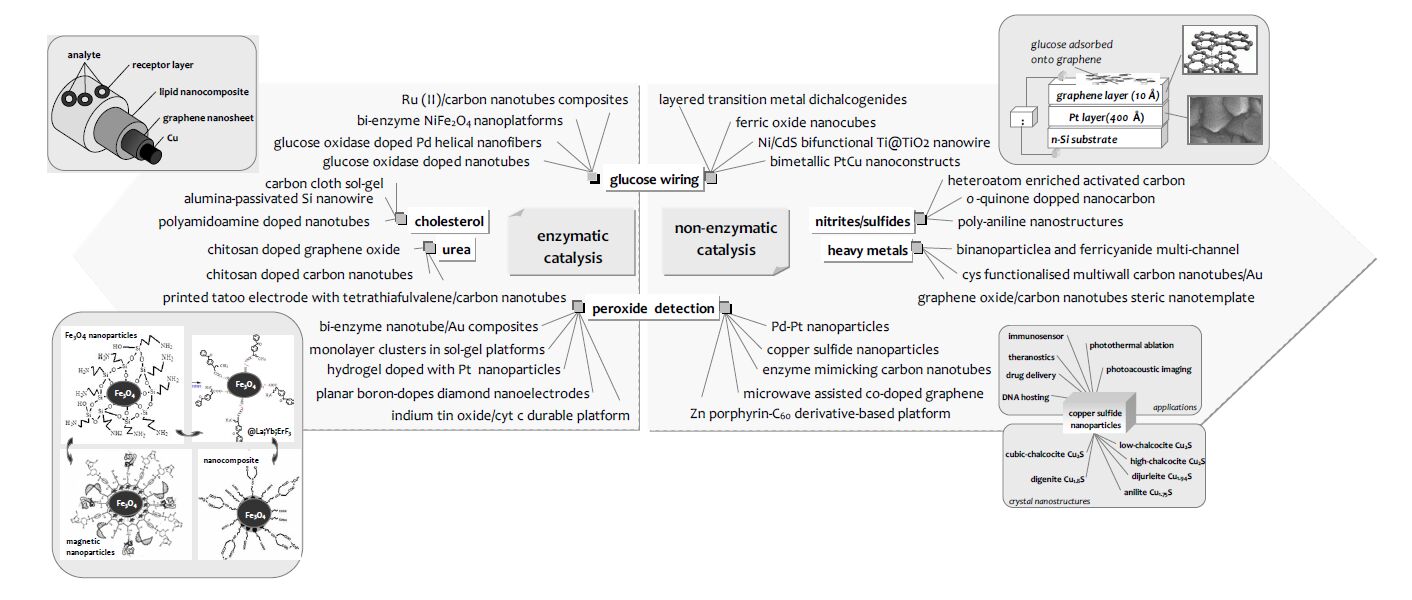1. Introduction
The (bio) medical device sector, highly dynamic and diverse, has been at the forefront of research and public interest for more than three decades now. The sector experiences a high demand-driven absorptive capacity, i.e., a marked science-based value [1], which improves its innovation performance and competitive advantage. This rapid assimilation of exogenous technological change necessitates competent internalization mechanisms that should be efficiently coupled with a worthwhile market-based rate of return in the portfolio of products [2]. The value chain drawn is based on intense university-industry alliances and multidisciplinary collaborations with a view to translating proofs-of-concept or, even, proofs-of-principle, to hand-held devices, implantable monitors, or molecular diagnostics platforms [3]. Nanotechnology holds undoubtedly a central role within this innovation system, facilitating the generation of new concepts and the revisiting of older ones.
Within this frame, nanotechnology has been vigorously addressed as a discontinuous and disruptive technology that facilitated the shifting of market trajectories towards products with superior performance and qualities that health care providers and patients valued [4]. For example, the scale-length reduction that has been achieved through nanosynthesis (bottom-up technology) and nanomachining (top-down technology) provided countless opportunities for point-of-care, non-invasive or implanted miniaturized monitors, personalized drug delivery systems or artificial organs. Patent applications in the biomedical sector witnessed an annual growth rate of 15% for the period 1996 to 2002, which rapidly escalated to 28% thereafter [5] and now reaches almost 54% [6]. Academic institutions hold a considerable share of patents, scoring high values for importance of innovations, generality of research outcomes, and reliance on scientific sources [7]. The impact of the knowledge exploration path, traditionally assumed by the academy, to the technology exploitation path, represented by the industrial sector, is, also, evident by the citations found in the patents filed by the latter, 68% of which refer to university output [8].
As much of the work in the sector involves R & D, it is crucial that all players involved work together efficiently. Knowledge transfer between academia and the industry has become increasingly institutionalized as universities, on one hand, enhance their economic and societal value through new technology spin-offs or start-ups, while industry, on the other, secures future technologies. The "linear" academia-to-industry transition path, i.e., the traditional front-science producing role of university and end-technology producing role of industry, has been re-structured into an iterative, back and forth, process between universities and industry. The understanding of this new university-industry alliance may be a critical parameter in determining the R & D value of nano-enabled biomedical devices [9].
Long before the nanotechnology era, biosensors were using nano-sized biological moieties or systems (enzymes, cells, DNA, receptors, etc.) [10] to produce miniaturized detectors (such as microelectromechanical systems [11,12] or microarrays [13]) that promoted intense collaborations towards developing lab-on-chips [14], artificial sensing organs and implantable disease regulators [15]. Without nanotools available, device engineering, optimization and control had to be based on macro- rather than micro-parameters, and proven more or less successful in most cases (see e.g., the relevant reviews [16,17,18]. The advent of nanotechnology has been perceived in different ways, scales and rates by the various biosensor classes. For example, glucose self-monitoring ensured an early and aggressive industry interception that was fast to adapt the nano principles in engineering, materials, and processes [19]. Ion selective field effect transistors (ISFETs) still experience an iterative academy-to-industry-to-academy optimization [20]. Bilayer lipid membrane (BLM) platforms underwent numerous technology shifts that even facilitated their penetration into other research domains (such as the membrane permeability testing of drugs [21] or electrophysiology studies [22]); yet, most research remained within academia and only a limited transition to industry has been demonstrated [20]. Surface plasmon resonance (SPR) platforms, on the other hand, have expressed a high commercialization potential that, since 2005, has ensured their inclusion in the technology roadmaps [23].
This paper studies the nanotechnology-driven shifting of the biosensor innovation system towards new concepts and the broadening, in depth and extent, of its science base. The emerging trends open new avenues in clinical diagnostics and future trajectories.
2. Methodology
The biosensor system of innovation has been studied herein from 1980 till 2016, with a view to establishing the biotechnology-fueled frame and its shifting through the nano era. Using the data search strategy proposed by Mogoutov and Kahane [24], an extensive search in scientific and technical literature revealed 13,353 papers (Web of ScienceTM) and 9,929 patents (World Intellectual Property Organization) on biomedical devices based on biosensor principles. Since the domain of biosensors still lacks a coherent and widely acceptable vocabulary of terms [25], multiple search queries were used; for example, the search on "bilayer lipid membrane biosensors" had to include variants, such as "lipid thin film" or "lipid-bilayer composites". The data set produced was categorized according to specific subjects, such as "glucose", "electrochemical", "optical", etc.; then, the subject categories were grouped into macro-categories: analytical chemistry, instrumentation, materials, engineering, biophysics, etc. Duplicates have been identified by matching author, year and title fields and evaluated manually for deletion. Scientific literature has been used to investigate (a) industrial involvement, (b) research patterns and trends, and (c) the impact of the nanotechnology trajectory on the biosensor domain.
Based on the notion that co-authorship in a paper is a statement of collaboration [26], co-authorship analysis has been used to understand and assess university-industry collaboration patterns. On any given Web of ScienceTM set, the co-authorship networks have been visualized with the program Co-auth.exe [1].
The elucidation of research trends in academic output is neither straightforward nor easy. Looking into the large number of scientific publications on biosensors, two major trails in research may be seen: (i) knowledge production per se, involving researchers that capitalize fast on new technologies in order to demonstrate the feasibility of new concepts without regard to device engineering or optimizations, and (ii) problem solving, involving researchers that optimize previously published systems for detection limit, selectivity, operational stability, response time, etc. The former is interesting but lacks predictability, as no-one knows whether (and when) other researchers will be attracted to those concepts and translate the knowledge into operational detectors. On the other hand, the concentration of some groups on a given system (or system class) and the efforts made to overcome operational problems indicate a prospect on its own and a higher certainty for system completion (either successful or not). These are the cases that have been isolated and studied herein.
The trends and patterns in scientific literature have been investigated using the algorithm developed by Chen [27] for producing scientific maps and overlays. The scientific domain of (nano) biosensors has been studied using the roadmapping framework presented in [20], especially developed for academic research. The framework identifies the main clusters developed and examines the dynamic shifting of their within-university scope of research, through given time periods and elements of the scientific domain, as the result of technology and know-how transfer from other (relevant or distant) domains. In brief, a modified analytical hierarchy process [20] is used to obtain strategic information on the development of the various technologies (or research paths) fostered within academia; the value of each technology is determined with respect to the impacts of its characteristics on the sector's objective (defined by the technology creators) in each time period. By tracking the development progress of each research path over time, any changes observed on the value of technology, especially in the case of inferior technology paths (classified as such in the frame of reference) achieving dominancy, would represent the degree to which the biosensor society perceives the values on the improvement of technologies.
This methodology assesses, in effect, the capacity of the biosensor domain to transform the exogenously produced knowledge into a disruptive innovation that revolutionizes all upstream and downstream processes, from basic research front to a new techno-economic network (transition to industry).
3. Established Biosensor Clusters and the Innovation System
Biosensors are compact devices that mimic natural chemoreception schemes: biological components react with the analyte of concern to produce biochemical information, readily translated into an electric signal by a chemical transducer (Figure 1). Thereby, the analytical characteristics of any device depend upon the intra-component properties and inter-component correlations: specificity is assigned by the biological system used [28], response times are determined by the transducer [29], miniaturization comes mostly inherent by the nanosize of the biological moieties [30], and inherent signal amplification capabilities are determined by the bioelement-transducer interface [19].
Glucose sensors are undoubtedly the most successful cluster of the biosensor technology. The strong and effective university-industry alliance that has been formed at the 1980's provided revolutionary solutions in scientific and technical problems. While industry was rapidly intensifying the pull-basis towards device improvements, academia was extending the science base adopting biotechnology tools [20]. As university publications on glucose sensing kept increasing on increasing annual rates (Figure 2), patenting was limited (Figure 3); one of the main reasons for the limited number of patent submissions by the university was the (still) prevailing "publish or perish" motto [31]. The contribution of industry in academic research reached a minimum at early 2000's and revived towards the end of the decade, investing on nanotechnology and the possibility to market new concepts in diagnostics: in vivo monitoring, artificial pancreas, targeted therapy [19]. The patent boost that followed included universities as a significant player (Figure 3), although their scope of research preserved the knowledge production profile [20].
Ion selective field effects transistors (ISFETs) shape another biosensor cluster, highly populated and productive due to (a) the well-established technological background in chemical sensing that was readily transformed to biochemical (by simply replacing chemical recognition with a biochemical one on the same transduction platform) [32], and (b) the catheter-type architecture, amenable to size reductions and quite suitable for in vivo clinical diagnostics [33]. The reliability of the devices became early an issue of concern, as electrode drift hindered the applicability of the sensor in clinical samples. A lot of research has been focused in problem solving and much of the technology produced was commercialized (e.g., the pH probes) along with several signal compensation algorithms [32]. The main cause of the problem lies on the inability of photolithographic patterning to seize theory [20]. Nanopatterning offered better control in device construction, although the monitoring of biochemical reactions (i.e., at low-voltage applications) remains problematic [34]. Industry translated the new manufacturing approach in economic terms: the more the downsizing, the higher the cost of the apparatus. Academia turned to alternative methods, such as the spacer technique presented in [35] that has yet to prove its suitability in clinical samples.
Membrane biosensors mimic closely biological sensory functions and form another research cluster that experienced a cyclic pattern in scope and limited transition to industry. Lipid membranes are two-dimensional fluid nano-structures where basically two lipid layers are held together by non-covalent hydrophobic interactions of amphipathic molecules. The nano-sized sensing layer ensures ultra-fast response times [36] and makes the use of expensive molecules (as DNA) economically feasible. Lipid bilayers spanning an aperture that separates two electrolyte solutions (freely suspended BLMs [37]) delivered, at early 1990's, superior sensitivity that could not be read at the instrumentation available; further, the films were very difficult to stabilize for yielding a rugged device [38]. The research followed produced thick hybrid platforms gaining in stability and ruggedness but lacking in sensitivity, applicability, and interest [20]. Nanotechnology revived lipid film platforms, offering the means to control the thermodynamically-driven lipid self-assembly processes and monitoring femtomolar concentration levels: graphene tools and polymerizable lipids yielded new opportunities in utilizing membrane physics for reliable clinical analysis [39], whereas new applications in electrophysiology boosted research for single-channel monitoring [40] and drug testing [41].
Optical biosensors enjoyed a lot of attention, especially in conjunction with surface plasmon resonance (SPR) technology. The cluster invested heavily on functionalization and performance (Figure 4), in an attempt to optimize biochemical kinetics [42] and increase sensitivity [43], respectively. SPR technology is included in commercial nanodevice roadmaps, setting the single molecule sensitivity feasible in the near future [23].
4. The Nanotechnology Disruption
Two major drives can be seen in the academic research path for clinical biosensors in general: exploration (basic research) and exploitation (applied research) of knowledge. Technology barriers were early recognized and various efforts were made to provide solutions. The scope of research, as seen in the published papers produced (Figure 5), involves analytical chemistry (device development), materials (bioelements and transducers), instrumentation (sensor architecture and signal processing), biophysics (analyte-bioelement and bioelement-transducer interface) and engineering (optimization and end-user adaptations). When nanotools became available, old concepts have been reviewed and new solutions have been provided.
The trends that had been established with the biotechnological tools were re-directed and re-evaluated to seize the nanotechnology potential. Bench-scale development and validation shows a steady-rate increase through biotechnology and nanotechnology eras. Instrumentation, follows a trail parallel to analytical development, since solutions in signal conditions, noise subtraction and the amplification options are inevitably topped by technology limitations. Yet, the few intra-university collaborations (utilizing institutional infrastructure), mostly evident at 1990's, have enhanced and shifted to inter-university alliances after 2010 (Figure 6), denoting a strong multi-disciplinary trend as a need for achieving complementarity of resources and capabilities. As a case in point, in 1994, intra-university collaboration accounted for 8.2% of the published papers in instrumentation (the best European representatives been the Gauglitz group from the University of Tübingen, Mascini group from the University of Firenze, and Turner's group in Cranfield University), whereas 1.74% represented inter-university alliances (as the result of researchers moving from US to Europe). After 2000, within university infrastructure remained a strong pole for collaboration; however, the circulation of researchers, both within Europe and in a global setting, brought about inter-university collaborations that in 2005 accounted for 29.3% of the published papers.
Progress in materials experienced a major disruption around 2010 (Figure 5), where nano-synthesis, patterning and control have been fully exploited to alter entirely the whole range of available types, sizes, properties, possibilities and physics. Significant (intra- or inter-university) collaborative efforts in the development of biomaterials can be seen after 2004, commonly in testing a new material in a biosensor platform (such as graphene-based 2D structures, see e.g., [44]) and less frequently in engineering (i.e., altering the physico-chemical properties of) a material to fit a specific biosensor platform and generate new benefits for the device (e.g., tuning the binding activity of a bioreceptor in order to achieve better orientation of the molecules at immobilization [45]). Notwithstanding, the development or engineering of a material from the same group that develops the biosensor is not uncommon; in most cases, however, this group has a strong multi-disciplinary composition. This observation is in agreement with the results from empirical studies of the nanomaterials domain published in literature (see e.g., [46,47,48]).
Biophysics played an important role in mid-1990's, when micro-devices required resolutions in surface chemistry and thermodynamic stability issues [28]. Size reduction to nano dimensions brought along a new dependency on biophysics (Figure 5) in order to understand the deeper aspects of biology [49]. A similar trend can be observed in engineering, which seems to have attracted a lot of research interest (Figure 5) after 2010.
Although collaboration has been always a necessity in device engineering (Figure 6), the nano era urged for more multi-disciplinarity to accommodate the new scientific content: the so-called next generation devices utilize (i) new classes of materials, (ii) new strategies for coupling biomaterials to transducers, and (iii) new optimization and control tools, all in an integrated way. During the 1990s, collaborative publications reached 35%, 22.2% referring to intra-university efforts. During 2000s, joint papers accounted for 48% of the total publication volume in engineering, 31% of which involved more than one institution.
5. The New Prospects in Biomedical Diagnosis
Nanosynthesis, nanomanufacturing and the related control tools have revolutionized device architecture while advancing modes of operations for clinical diagnostics. Looking into the materials trail, the coupling of biological moieties with new electrochemical transduction platforms, in both, bioelement immobilization and information transfer, is a case in point. Glucose sensors, for example (Figure 7), found a completely new approach for glucose wiring in non-enzymatic catalysis schemes [50]: bimetallic PtCu nanoconstructs, bifunctional nanowires ferric oxide nanocubes or dichalcogenides enhance electrode transfer and diminish interferences. Traditional detection strategies offered new enzyme immobilization solutions on 3D hydrogel heterostructures [51] or 2D nanocomposites [52]. Iron oxide nanoparticles support enzymatic detection [53], while copper sulfide crystal nanostructures support non-enzymatic catalysis [54]. Carbon-based platforms or polymer nanostructures can be readily converted to templates for anions or heavy metals [55]. Chitosan chemistry is more linked to carbamides, whereas polymerizable films are used for sterols [52].
Graphene-based nanomaterials have added a new perspective in electron transport, thermal conductivity, mechanical flexibility, and biocompatibility, along with a large surface-area-to-volume ratio that seems to attract the interest of the industry [55,56,57,58,59]. The edge plane sites/defects that occur at the end of graphene sheets were proved advantageous as they act as nanoconnectors that electrically transport the electrons to underneath the substrate [57,58]; because of its large surface area and abundant oxygen-containing groups, graphene oxide can be used as a carrier to load a large amount of antibodies through amide condensation reaction or electrostatic interaction with protein [55]. Graphene platforms can be readily converted to nanocarriers, allowing for multienzyme signal amplification [59].
When assessing, however, the impact of these technology opportunities on the analytical chemistry trail (impact is assessed by the number of diverse groups concentrated on any given element of the domain, as e.g., on graphene tools), certain conclusions can be drawn as regards dominance. Carbon-based and iron oxide modified transducer platforms (Table 1) can be used as an example. Carbon-based nanoplatforms [60,61,62,63,64,65,66,67,68,69] offer, indeed, femtomolar detectability [60,63,66] or less [62], ample possibilities in hybrid architectures [67,68,69] and ruggedness in lipid platforms [64,65], but limited in electrochemical transduction.
Iron oxide technology [70,71,72,73,74,75,76,77,78,79,80,81], on the other hand, seems to be more diverse as it can be adopted to more transduction options. The range of transducers that can successfully host these nanoplatforms is quite wide, involving volatmetric, amperometric, piezoelectric and optical principles, suggesting a high degree of integration and applicability that could be translated into marketed products.
Iron oxide nanoparticles have been widely proposed for the collection and separation of biomolecules, targeted drug delivery and biomedical applications [70,71,72,73,74,75,76,77,78,79,80,81]. The immobilization of bioelements on the surface of the nanoparticles is straightforward; via amino groups [75,79,80,81], cross-linkers [70,71,72,73], or entrapment in polymer matrices [76,77,78]. The produced bioconjugates can sufficiently deliver or recover analytes in biomedical applications. Due to the submicron size and the physicochemical properties, iron oxide nanoplatforms provide a favourable micro-environment for the conjugation of moieties such as DNA [74], proteins and enzymes [75,76,77,78,79,80,81], with improved sensitivity.
Notwithstanding, the scientific content of the engineering trail persistently promotes an entirely new concept: nano-biolectronics. The trail is represented by a thick innovative network that continues to expand at a steady pace. In brief, nanomaterials are integrated with biology and electronics in order to overcome existing challenges in biosensors. The downsizing of electronic transducers affords them a more nature-relevant and biocompatible character that is expected to bring sensitivity to near-nature levels [82]. Nano-bioelectronic devices enable the study of the neural circuits at both cellular and subcellular resolution [83]. Nanowire-nanotube heterostructures can penetrate cell membranes for minimally invasive recordings; when coupled with phospholipid functionalization, these nano-probes can facilitate spontaneous membrane penetration and a tight, high-resistance probe/membrane seal [84]. Intracellular sensing becomes possible, opening new avenues in biomedical diagnostics and biosensor value chain.
Table 1. Nanostructures employed in diagnostic devices based on carbon-based and iron oxide based technology.
| Sensor type |
Nanoparticles and nanostructures |
Detection limit * |
Analyte |
Ref.
|
| chemiresistor |
single wall carbon nanotubes |
1 fg/mL |
cardiac troponin |
[60]
|
| chemiresistor |
single wall carbon nanotubes |
24.2 pg/mL |
myoglobin |
[61]
|
| chemiresistor |
single wall carbon nanotubes |
0.1 aM |
microRNA-122a |
[62]
|
| chemiresistor |
chemically reduced graphene oxide |
100 fg/ml |
prostate specific antigen |
[63]
|
| lipid membrane |
graphene electrodes |
1 nM |
cholera toxin |
[64]
|
| lipid membrane |
graphene electrodes |
1 μΜ |
D-dimer |
[65]
|
| chemiresistor |
chemical vapour deposited graphene |
10 fM |
22-mer target ssDNA |
[66]
|
| amperometric |
nitrogen doped graphene @ cobalt phthalocyanine |
1 μM |
thiols and mycotoxins |
[67]
|
| amperometric |
graphene oxide@amino-functionalized carbon sphere |
24 nM |
maltol |
[68]
|
| voltammetric |
polyanilino@graphene quantum dots |
0.097 mg/L |
heavy metals |
[69]
|
| voltammetric |
Fe3O4@Au nanoparticles |
0.22 ng/mL |
clenbuterol |
[70]
|
| voltammetric |
Fe3O4@SiO2 |
18 nM |
metronidazole |
[71]
|
| voltammetric |
Fe3O4@SiO2/carbon nanotubes |
0.13 µM |
uric acid |
[72]
|
| voltammetric |
Fe3O4@Au nanoparticles |
20 μM |
peroxide |
[73]
|
| electrochemical impedance |
Fe@Au-graphene nanoparticles |
0.02 fM |
DNA |
[74]
|
| electrochemical impedance |
Fe3O4 nanoparticles |
0.25 ng/mL |
Bacillus Cry1Ac protoxin |
[75]
|
| fluorescence |
Fe3O4@Au nanoparticles |
N/A |
Desulfotomaculum spp. |
[76]
|
| quartz crystal microbalance |
Fe3O4@SiO2 |
0.3 pg/ml |
C-reactive protein |
[77]
|
| quartz crystal microbalance |
Fe3O4@SiO2 |
0.3 pg/ml |
myoglobin |
[78]
|
| superconducting quantum interference |
Fe3O4 nanoparticles |
1.3 × 106 cells |
MCF7/Her2-18 breast cancer cells |
[79]
|
| SPR |
Fe3O4 nanoparticles |
0.02 nM |
thrombin |
[80]
|
| SPR |
Fe3O4 nanoparticles |
0.65 ng/ml |
α-fetoprotein |
[81]
|
| * as stated by the cited authors |
6. Conclusions
The drive in biosensor research remains still the exploration of natural chemoreception or the exploitation of its concept, i.e., of the analytical sensitivity and selectivity of biological moieties. In the biomedical sector, the devices developed in universities throughout the biotechnology revolution addressed clinical diagnostics quite successfully in certain areas, such as disease marker detection, or therapeutic compound identification and analysis, before reaching its scientific and technological limits. The nanotechnology era offered, undoubtedly, the means to exceed these limits and translate successfully nanoeffects into more reliable hand-held or implanted monitors. Yet, a new transition becomes evident towards bioelectronic integration that sets entirely new horizons for future trajectories.
Conflict of Interest
The authors declare that there is no conflict of interest regarding the publication of this manuscript.









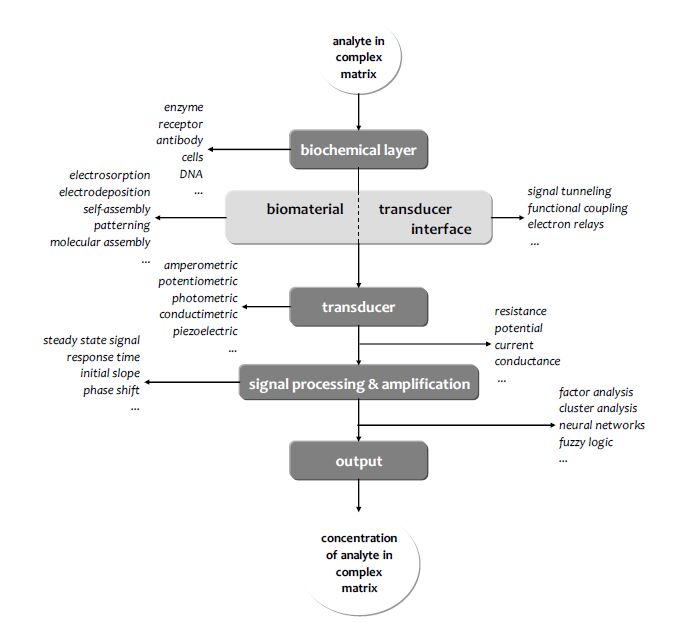
 DownLoad:
DownLoad: 